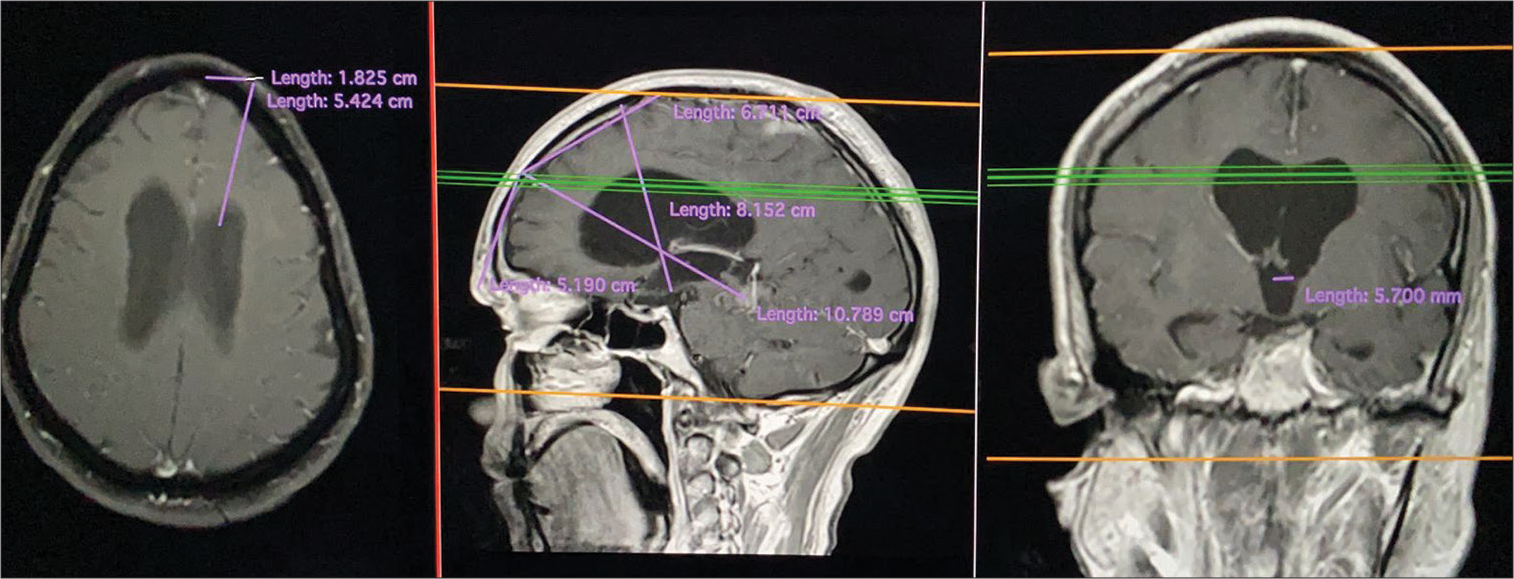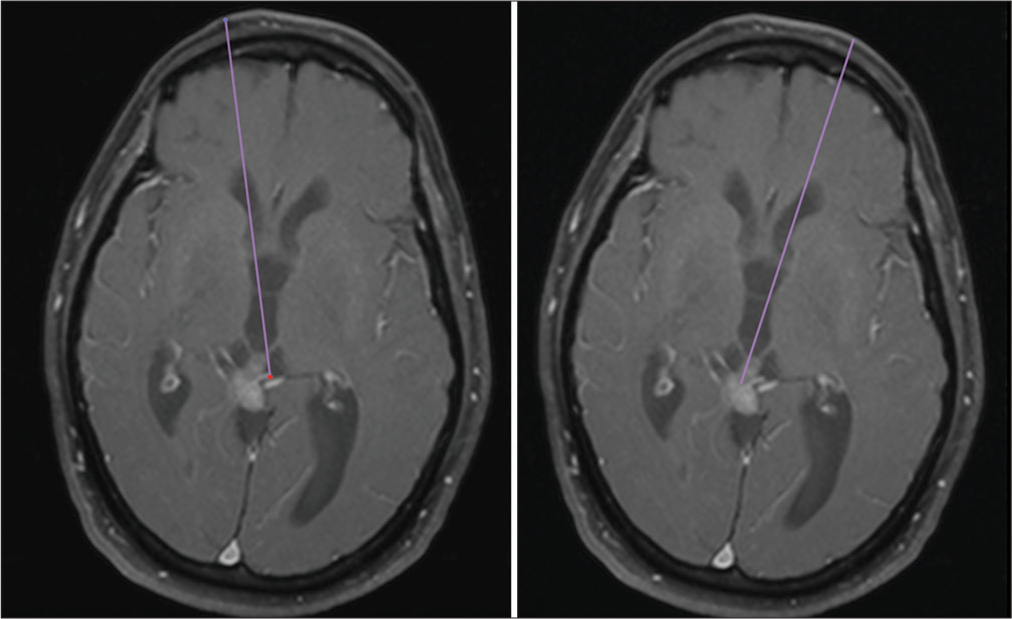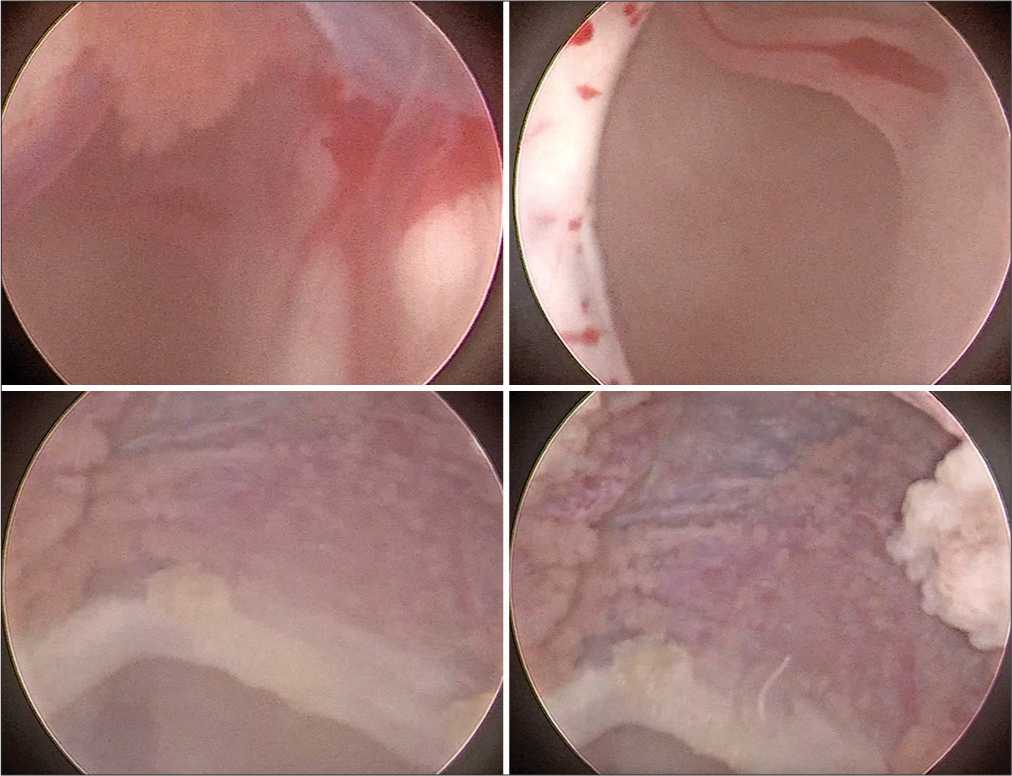- Department of Neurosurgery, Southern Medical Clinic, San Fernando, Victoria, Trinidad and Tobago.
Correspondence Address:
Panduranga Seetahal-Maraj, Department of Neurosurgery, Southern Medical Clinic, San Fernando, Victoria, Trinidad and Tobago.
DOI:10.25259/SNI_977_2021
Copyright: © 2021 Surgical Neurology International This is an open-access article distributed under the terms of the Creative Commons Attribution-Non Commercial-Share Alike 4.0 License, which allows others to remix, tweak, and build upon the work non-commercially, as long as the author is credited and the new creations are licensed under the identical terms.How to cite this article: Panduranga Seetahal-Maraj, Patrick Knight, Narindra Ramnarine. A bi-foraminal craniometric-guided approach to endoscopic third ventriculostomy and biopsy of a pineal tumour. 30-Nov-2021;12:582
How to cite this URL: Panduranga Seetahal-Maraj, Patrick Knight, Narindra Ramnarine. A bi-foraminal craniometric-guided approach to endoscopic third ventriculostomy and biopsy of a pineal tumour. 30-Nov-2021;12:582. Available from: https://surgicalneurologyint.com/surgicalint-articles/11259/
Abstract
Background: Pineal tumors are very rarely encountered, with an incidence of
Case Description: A 55-year-old male presented with signs of intracranial hypertension and was found to have obstructive hydrocephalus due to a pineal tumour. The tumour displayed a right-sided dominance when the pre-operative imaging was assessed, which would risk forniceal injury if biopsied via a right-sided burr hole. Craniometric measurements revealed a superior trajectory to the tumour via the left foramen of Monro. A biforaminal approach was performed, with a traditional ETV using a right coronal bur hole and biopsy via a left frontal bur hole. This minimized forniceal stretching and allowed a safe biopsy.
Conclusion: The bi-foraminal approach has not been widely described in the literature but can potentially avoid morbidity with biopsy in patients with right-sided pineal tumours. We believe this technique should be considered, particularly in low-resource settings where neuroendoscopy is not commonly done, and where the use of ipsilateral single or dual-bur holes may lead to forniceal injury.
Keywords: Biforaminal approach, Craniometrics, Endoscopic third ventriculostomy, Pineal tumour
INTRODUCTION
Tumours of the pineal gland are very rarely encountered, with a quoted incidence of less than 1% of all intracranial lesions in adults. Life-threatening hydrocephalus from obstruction of the third ventricle may occur, due to the location of these tumours. Endoscopic third ventriculostomy (ETV) and tumour biopsy is known to be a safe and feasible strategy, particularly if the tumour appears benign. This mitigates the high risks of uncontrollable venous bleeding from open and stereotactic biopsies.
It is typically performed using either ipsilateral single or dual bur holes, which are placed with the guidance of neuronavigation. However, the location of the tumour may require modifying of the standard endoscopic techniques. This is particularly true in settings where neither neuronavigation nor flexible endoscopes are available, and craniometric measurements must be used to facilitate safe and accurate tumour biopsy. We report on a case of a pineal tumour with obstructive hydrocephalus, in whom a bi-foraminal approach to ETV and biopsy was utilized, with a good neurological outcome.
CASE REPORT
A 55-year-old male presented to the outpatient clinic with generalized headaches and blurred vision for 1-month’s duration. He noted progressive worsening of the headaches, and they were particularly harsh on mornings, graded as 7/10 severity. They were not associated with nausea/vomiting, fever or seizures. His blurred vision prevented him from driving, and he noted that it had progressively declined. He had no known medical comorbidities, and the remainder of his history was unremarkable.
Physical examination revealed a fit-looking man who was haemodynamically stable. He was oriented to time, place and person and had a normal gait. Sensorimotor examination did not reveal any deficits. Pupillary assessment was within normal limits, at 3 mm and reactive to light and accommodation bilaterally. There were no gaze palsies or ophthalmoplegia, and no evidence of Parinaud’s syndrome. Visual acuity was reduced to 20/40, but visual fields were spared. Fundoscopy was positive for mild disc oedema.
The patient had an urgent magnetic resonance imaging (MRI) brain done [
Figure 1:
Top row–axial T1 (left), T2 (middle) and sagittal T2 (right) magnetic resonance imaging (MRI) showing pineal tumour dorsal to the midbrain, and resultant aqueductal stenosis. Bottom row–axial (left), sagittal (middle) and coronal (right) T1 post-contrast MRI showing homogenous enhancement of lesion, obstructive hydrocephalus and surrounding vascular structures.
Differential diagnoses of pineocytoma, germ cell tumour and metastasis were considered. Computed tomography scans of the chest, abdomen and pelvis did not reveal any evidence of malignancy. Hematological investigations including and serum germ-cell markers (alpha-fetoprotein, beta-human chorionic gonadotropin, placental alkaline phosphatase) were within normal reference ranges. The goals of management at this time were to divert CSF and obtain a tissue diagnosis. A decision was made to proceed with endoscopic third ventriculostomy (ETV) and pineal tumor biopsy. This was due to the high ETV success score calculated in this patient (over 90%).
Craniometric measurements were taken to determine the simplest route to the tumor, since neuronavigation is not available in our setting. The ETV would be performed through a standard right coronal bur hole, however, a separate left frontal-precoronal bur hole was decided to be appropriate for the biopsy. This tumor had a right-sided predominance, and possible trajectories through the right foramen were not leading to the tumour. A direct and simple trajectory would however be achieved by the use of a left-sided bur hole [
Figure 2:
T1 axial (left, sagittal (middle) and coronal (right) magnetic resonance imaging showing craniometrics for endoscopic third ventriculostomy (ETV) at the floor of the third ventricle, and ideal trajectory for tumor biopsy. As noted on the sagittal image, there was a significant distance between the ideal trajectories for the ETV and biopsy, necessitating dual bur holes. The left frontal pre-coronal bur hole was placed 5.19 cm from the glabella, with a measured distance of 10.789 cm to the tumour. The right coronal bur hole for the ETV was placed 11 cm from the nasion, with a measured distance of 8.15 cm to the floor of the third ventricle.
The patient was placed under general anaesthesia and positioned supine. The head was kept neutral and slight neck flexion was done, and then secured in the Mayfield head clamp. A right Kocher’s point bur hole was placed, and the right lateral ventricle cannulated with an external ventricular drain. CSF samples were taken at this time, to assess for germ-cell tumour markers and cytology. The ventricular drain was removed, and a rigid 0-degree endoscope then introduced. Confirmation of correct position was done by identifying landmark anatomic structures (septal vein, choroid plexus, thalamostriate vein). The foramen of Monro was entered and care taken to avoid injury to the fornices. In the third ventricle, the basilar artery was identified and the ventriculostomy then performed safely away from it. Flow of CSF through the ventriculostomy was noted, and there was no vascular injury.
A second low left frontal bur hole was then made, allowing the shortest safe linear trajectory to the pineal tumour. The third ventricle was entered, and the tumor was identified as a red, vascular lesion on the posterior wall of the third ventricle [
Figure 4:
Clockwise from top left–endoscopic entry into the left foramen of Monro, with choroid plexus, septal vein and thalamostriate vein visible. Top right–view within foramen of Monro. Bottom right–view of vascular appearing pineal tumor from the third ventricle. Bottom left–forniceal columns inferior to tumor.
Post-operatively, the patient reported immediate cessation of headaches and resolution of his blurred vision. The drain was removed on postoperative day 2, and he was discharged on day 5. All CSF samples were negative for germ-cell tumour markers and cytology. Final histology was consistent with a pineocytoma, with conservative management and serial imaging as the management strategy. At a 4-month follow-up, the patient remains asymptomatic.
DISCUSSION
Pineal region tumors have an incidence of 1% of intracranial lesions in adults, and as high as 10% in the pediatric population.[
Up to 90% of these tumors present with potentially life-threatening obstructive hydrocephalus, which requires urgent management prior to addressing the tumor.[
The role of endoscopy
The use of the endoscope in the management of these tumors serves two purposes, CSF diversion and histological diagnosis. Treatment of hydrocephalus by CSF diversion can be safely and effectively done via ETV. The ETV success score predicts the likelihood of a good outcome in these patients and has been validated in adults.[
Simultaneous biopsy of the tumor can be done, either using the same bur hole as for the ETV or a separate one. The availability of neuronavigation can aid in determining the ideal bur hole placement, or this trajectory can be calculated based on imaging studies.
When both procedures are planned to be done simultaneously, the ETV takes precedence. The rationale for this is to both address the more pressing concern of hydrocephalus, and prevent obscuring of anatomy if there is bleeding from the biopsy.[
Single versus dual bur holes, and the bi-foraminal approach
ETV is traditionally done using a right-sided coronal bur hole which allows visualization of the floor of the third ventricle and avoids potential injury to the eloquent speech area in the left hemisphere. The ideal trajectory for a pineal tumour biopsy is done by an ipsilateral frontal/pre-coronal bur hole that aims at the posterior third ventricle.[
In settings where neuro-endoscopic procedures are not commonly done, and where neuronavigation is unavailable, the use of ipsilateral single or dual-bur holes in cases such as these may unnecessarily risk intraoperative cortical bleeding, forniceal contusions and basilar artery injury.[
In our case, given the lack of flexible endoscopes and the relative right-sided location of the tumour [
A separate, contralateral left-sided bur hole, therefore, afforded a superior trajectory to the tumour, while reducing the above-mentioned risks. While this technique has not been specifically described in the literature, it should be considered as an option in tumours that may not be accessible via an ipsilateral bur hole to the ETV. The value of the biforaminal approach increases when only rigid endoscopes are available, and even more so when there is no accessible neuronavigation.
Biopsy success rate
Balossier et al. compared several series in 2015 and found a range of 60–100% positive endoscopic biopsies of pineal region tumours.[
Risks and complications
If there is a failure of resolution of hydrocephalus, patients may require eventual VPS. However, the ETV success score allows prediction this, and some authors have reported a 1% chance of requiring shunting after ETV.[
Hemorrhage from intraventricular surgery has a reported rate of 4.8%.[
Short-term memory loss from forniceal contusions is documented after this procedure, but fortunately quite rare.[
CONCLUSION
The bi-foraminal approach to combined ETV and biopsy for pineal tumours can be utilized to enable safe tumour biopsy. The tumour location should be studied carefully on preoperative imaging, to guide the placement of bur holes using craniometric measurements. While typically ipsilateral single- or dual-bur holes are done, this may unnecessarily risk forniceal injury, especially if only rigid endoscopes are available. This technique is an additional strategy available to neurosurgeons, particularly in regions where there is a lack of readily accessible neuronavigation. This necessitates careful study of preoperative imaging and accurate craniometric measurements, for a safe and successful procedure.
Declaration of patient consent
The authors certify that they have obtained all appropriate patient consent.
Financial support and sponsorship
Nil.
Conflicts of interest
There are no conflicts of interest.
References
1. Abbassy M, Aref K, Farhoud A, Hekal A. Outcome of single-trajectory rigid endoscopic third ventriculostomy and biopsy in the management algorithm of pineal region tumors: A case series and review of the literature. Childs Nerv Syst. 2018. 34: 1335-44
2. Amer MA, Elatrozy HI. Combined endoscopic third ventriculostomy and tumor biopsy in the management of pineal region tumors, safety considerations. Egypt J Neurosurg. 2018. 33: 4-9
3. Balossier A, Blond S, Touzet G, Lefranc M, de Saint-Denis T, Maurage CA. Endoscopic versus stereotactic procedure for pineal tumour biopsies: Comparative review of the literature and learning from a 25-year experience. Neurochirurgie. 2015. 61: 146-54
4. Kulkarni AV, Drake JM, Kestle JR, Mallucci CL, Sgouros S, Constantini S. Predicting who will benefit from endoscopic third ventriculostomy compared with shunt insertion in childhood hydrocephalus using the ETV Success Score. J Neurosurg Pediatr. 2010. 6: 310-5
5. Labidi M, Lavoie P, Lapointe G, Obaid S, Weil AG, Bojanowski MW. Predicting success of endoscopic third ventriculostomy: Validation of the ETV success score in a mixed population of adult and pediatric patients. J Neurosurg. 2015. 123: 1447-55
6. Morgenstern PF, Osbun N, Schwartz TH, Greenfield JP, Tsiouris AJ, Souweidane MM. Pineal region tumors: An optimal approach for simultaneous endoscopic third ventriculostomy and biopsy. Neurosurg Focus. 2011. 30: E3
7. Morgenstern PF, Souweidane MM. Pineal region tumors: Simultaneous endoscopic third ventriculostomy and tumor biopsy. World Neurosurg. 2013. 79: S18.e9-13
8. Robinson S, Cohen AR. The role of neuroendoscopy in the treatment of pineal region tumors. Surg Neurol. 1997. 48: 360-7
9. Samadian M, Maloumeh EN, Shiravand S, Ebrahimzadeh K, Sharifi G, Mousavinejad A. Pineal region tumors: Long-term results of endoscopic third ventriculostomy and concurrent tumor biopsy with a single entry approach in a series of 64 cases. Clin Neurol Neurosurg. 2019. 184: 105418
10. Soleman J, Guzman R. Neurocognitive complications after ventricular neuroendoscopy: A systematic review. Behav Neurol. 2020. 2020: 2536319
11. Wasi MSI, Sharif SY, Gulzar F. Implication of image guidance in endoscopic third ventriculostomy: Technical note. Surg Neurol Int. 2020. 11: 87










